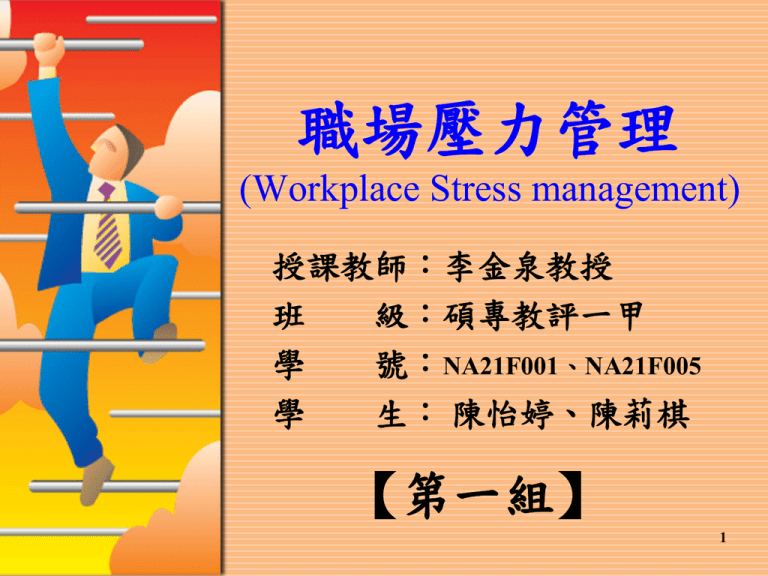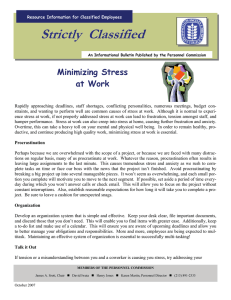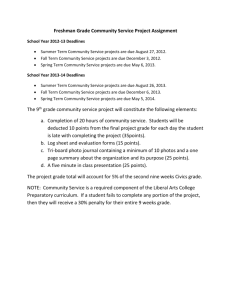職場壓力管理 【第一組】 (Workplace Stress management) 授課教師:李金泉教授
advertisement

職場壓力管理 (Workplace Stress management) 授課教師:李金泉教授 班 級:碩專教評一甲 學 號:NA21F001、NA21F005 學 生: 陳怡婷、陳莉棋 【第一組】 1 工作要求 ( Work demands ) 2 婷 要 求 包括工作量、工作模式以及工作環境等問題 DEMANDS Includes issues like workload, work patterns, and the work environment 3 婷 標準如下: 員工表示,他們能夠應付他們的工作要求;和 體制能適時地回應每個人的要求。 The standard is that: Employees indicate that they are able to cope with the demands of their jobs; and Systems are in place locally to respond to any individual concerns. 4 婷 什麼應該發生/要實現的狀態: 在商定的工作時間,該組織為員工提供足夠的 和可實現的要求; 人民的技能和能力與工作要求相匹配; 工作被設計成員工的能力範圍內; 員工對他們工作環境的憂慮得到解決。 What should be happening / states to be achieved: The organisation provides employees with adequate and achievable demands in relation to the agreed hours of work; People’s skills and abilities are matched to the job demands; Jobs are designed to be within the capabilities of employees; and Employees’ concerns about their work environment are addressed. 5 棋 要求:你做得不夠嗎? DEMANDS:ARE YOU DOING ENOUGH? 6 棋 有多大的工作量? 確保有足夠的資源分配來完成工作: 如果有不足的資源,尋求管理指導的優先次序。 支持你的員工,幫助他們優先處理或重新談判最 後的期限。 How much work is there? Ensure there are sufficient resources to do the work allocated: If there are insufficient resources seek guidance from management about priorities. Support your staff by helping them prioritise or renegotiate deadlines. 7 棋 負載員工缺勤期間的工作量。 調整工作模式來應付巔峰時段〈需要是公平 的並經過員工同意〉。 如果大家都是動力不足,思考給予他們更多的 責任,但要確保他們已經有充分的培訓。 Cover workloads during staff absences. Adjust work patterns to cope with peaks (needs to be fair and agreed with employees). If people are underloaded, think about giving them more responsibility, but make sure that they have been adequately trained. 8 棋 要確定員工是有興趣而忙碌的工作,並沒有 動力不足、工作超載或對工作感到困惑,以 求取之間的平衡。 制定個人工作計劃,確保員工知道他們的工 作內容包含哪些。 Strike a balance between ensuring that employees are interested and busy, but not underloaded, overloaded, or confused about the job. Develop personal work plans to ensure staff know what their job involves. 9 棋 員工是否勝任這項工作? 培訓和發展 培訓員工,使他們能夠完成他們的工作。 實現個人的發展/培訓計劃,要求個人識別發 展/培訓,並有機會可以跟管理者討論。 Are staff able to do the job? Training and development Train staff so they are able to do their jobs. Implement personal development/training plans which require individuals to identify development/training opportunities which can then be discussed with management. 10 棋 制定系統以保持最新的培訓記錄,確保員 工在核心職能的工作中,他們都是勝任和 自在的。 Devise systems to keep training records up to date to ensure employees are competent and comfortable in undertaking the core functions of their job. 11 棋 溝 通 處於初期階段,如果員工覺得無法應付工作, 鼓勵他們找你談談。 對無時效性計劃及任何特殊需要長時間的工作 ,制定系統去通知員工。 經常告訴你的團隊,哪些是需要完成的工作。 Communication Encourage staff to talk to you at an early stage if they feel as though they cannot cope. Develop a system to notify employees of unplanned tight deadlines and any exceptional need to work long hours. Talk to your team regularly about what needs to be done. 12 棋 這可以: 幫助您的團隊,了解他們目前正處於哪一種壓 力下的挑戰; 尋找方法,聰明的與團隊共享,並同意與團隊 共同攜手前進; This can: help you understand the challenges the team are currently facing and any pressures they are under; find ways of sharing the work sensibly and agreeing the way forward with the team; 13 棋 在你有計畫的工作中獲得團隊的凝聚和承諾 - 如果知道需要做些什麼時,這個團隊的反 應會更靈敏且容易達成計畫。 分配更多的工作在一個已經「捉襟見肘」的 團隊,無須解釋,那是毫無幫助的。 gain team cohesion and commitment to the work you have planned –the team is likely to be more responsive if it understands what needs to happen and by when. Allocating more work to an already stretched team without explanation is unhelpful; 14 棋 在無時效性計劃及任何特殊需要長時間的工作 ,去獲得團隊的凝聚和承諾; 這個團隊幫助你管理任何意外的缺勤或虧損每個人都知道團隊的關鍵階段和彼此的角色是 什麼。 以身作則。 gain understanding and commitment to unplanned tight deadlines and any exceptional need for long hours; help you manage any unexpected absences or losses to the team –everyone knows the key stages of the project and what each other’s role is. Lead by example. 15 棋 工作的環境有多好? 有適當和足夠的風險評估,來控制身體的危害。 更多信息可從英國健康安全局(Health & Safety Executive) 信息熱線得知:08701 545500 How good is the work environment? Have a suitable and sufficient risk assessment to control physical hazards. Further information is available from HSE Infoline: 08701 545500. 16 棋 評估身體暴力以及不當言語的風險。 採取的措施可以經由與員工的諮詢來處理,以及 其他可以幫助的人(例如警察,慈善機構)。 變更開始和結束時間,來幫助員工應付組織外部 的壓力(如照顧孩子,不佳的通勤路線)。 Assess the risk of physical violence and verbal abuse. Take steps to deal with this in consultation with employees and others who can help (eg the police, charities). Change start and finish times to help employees cope with pressures external to the organisation (eg child care, poor commuting routes). 17 棋 確保您的風險評估,對身體的危害和風險。 提供培訓,以幫助員工處理和化解困難的情況 (例如:困難的電話,公眾攻擊成員)。 Ensure your risk assessments for physical hazards and risks are up to date. Provide training to help staff deal with and defuse difficult situations (eg difficult phone calls, aggressive members of the public). 18 婷 1.工作要求 每個人都有一個天生的工作能力,如果一個人 的能力超過限度,這個人可能會遇到職業壓力。 1. Work demands Everyone has a given capacity for work and if a person’s capacity is exceeded the person may experience occupational stress. 19 婷 一些常見的工作要求包括: 時間上的壓力,包括時間和資源不足,無法完成 工作滿意,以及工作壓力太大或太快而難以達成 目標。 高度精神力的任務要求,譬如需要高層的決策或 長時間專注度的工作。 Some common work demands include: time pressure including inadequate time and resources to complete jobs satisfactorily, working too hard or too fast and difficult targets. high mental task demands such as work that requires high-level decision making or prolonged periods of concentration. 20 婷 工作單調和沉悶,或者不運用工作者的技能或 以前培訓的範圍。 高情感的任務要求,包括影響情緒的工作或需 要高情感的投入。 work that is monotonous and dull or does not utilise a worker’s range of skills or previous training. high emotional task demands, including work that is emotionally disturbing or requires high emotional involvement. 21 婷 長時間工作或加班,在休息時間工作或把工作 帶回家。 輪班是不可預知的,和/或影響睡眠的多寡和質 量,或使其工作和家庭生活難以平衡。 working long hours or overtime, working through breaks or taking work home. shift rosters that are unpredictable and/or affect amount and quality of sleep, or make it difficult to balance work and family life. 22 婷 工作要求 工作要求最常見的來源之一是與工作相關的壓力。 雖然工作者需要有挑戰性的任務來保持他們的興 趣和動機,並發展新的技能,重要的要求是不超 過他們的能力可以應付的範圍。 Work demands Work demands are one of the most common sources of work-related stress. While workers need challenging tasks to maintain their interest and motivation, and to develop new skills, it is important that demands do not exceed their ability to cope. 23 婷 工作者通常可以應付高要求的工作,如果工作不 是過份的,且他們能得到主管和同事的支持,並 能得到適量的自主權。 Workers can usually cope with demanding work if it is not excessive, if they are supported by supervisors and colleagues, and if they are given the right amount of autonomy. 24 婷 可能的解決方案 需要有切實可行的解決方案(控制措施)使用 在職場上的決定,以防止、消除或減少職業壓 力影響到員工的健康。 Possible solutions Decisions need to be made about what practical solutions (control measures) will be used in the workplace to prevent, eliminate or minimise the effect of occupational stressors on worker health. 25 婷 在組織層面上,控制目標工作本身和專注於工作 設計,以及工作環境和工作條件。 對於高風險因素的「高工作要求」,組織層面的 解決方案在於時間壓力,和太長或不規則工作時 間,心理需求、物理需求和情感需求。 At the organisational level, controls target the work itself and focus on job design, work environment and working conditions. For the risk factor ‘high work demands’, organisational level solutions address time pressure, long or irregular working hours, mental demands, physical demands and emotional demands. 26 婷 時間壓力 當有過分要求的工作量: 確保工作者有足夠的時間來完成他們的任務, 並允許他們投入當他們決定了時間的安排與步 調。 Time pressure When there is a demanding workload: Ensure workers have adequate time to complete their tasks and allow them to have input when determining the timing and pace of their work. 27 婷 確定績效目標時,與工作者協商所設定的目標必 需是實際的和可實現的,而且設定目標時需考慮 到現有的工作量。 基於團隊的目標是一項有效措施,提高了對組織 目標的總體性能和建立有效的團隊。 Consult with workers when determining performance targets, set targets that are realistic and achievable, and take into account existing workloads when setting targets. Team-based targets are an effective measure for improving overall performance against the organisational goals and building effective teams. 28 婷 定期檢討工作負載,以確保工作者有足夠的資 源(時間、行政支持或設備)來應付。 可以在團隊會議中,透過非正式與主管或通過 進行現場評估去審查工作負載。 Regularly review workloads to ensure workers have sufficient resources (in terms of time, administrative support or equipment) to cope. Workloads can be reviewed during team meetings, through an informal check-in with the supervisor or by undertaking worksite assessments. 29 婷 在顛峰需求的期間(例如:聖誕節,學校假期 或季節性高峰)監控工作負載,並在需要的地 方提供額外的支援。 協助工作者發展個人的工作計劃,以幫助他們 優先考慮他們的任務。 Monitor workloads during periods of peak demand (e.g. Christmas, school holidays or seasonal peaks) and provide additional support where required. Assist workers in the development of personal work plans to help them prioritise their tasks. 30 婷 協商完成任務的合理期限。限期要到了的期間,通 知員工最後期限的背後原因,以及為什麼他們必須 達成的重要因素。 要鼓勵員工說出,當員工在早期階段覺得自己的任 務需求過度,並在資源不足以致無法有效地完成任 務的情況下,需要尋求優先的管理指導。 Negotiate reasonable deadlines for completing tasks. During periods where deadlines are tight, inform workers of the reasons behind the deadlines and why it is important they are met. Encourage workers to speak up at an early stage if they feel their task demands are excessive and to seek guidance from management about priorities if there are insufficient resources to effectively complete the tasks. 31 婷 當有素質不足或素質過高的工作者: 重要的是工作者能勝任自己的工作,以及他們的 工作是有報酬的,因此: 設計能符合工作者能力的工作。 分配任務時能考慮工作者的技能和能力。 在需要的時候,提供培訓和技能發展。 When there are under- or over-qualified workers: It is important workers are competent at their job and that their work is rewarding, therefore: design jobs to be within workers’ capabilities consider workers’ skills and abilities when allocating tasks provide training and skill development when needed. 32 婷 開發一個系統,以保持培訓記錄是最新的, 確保工作者有能力和舒適地完成他們工作的 核心功能。 給員工不符合他們能力(太簡單)任務,如果 他們沒有接受到挑戰的工作時,他們可能會 感到沮喪和沒有動力。 Develop a system to keep training records up-to-date, ensuring workers are competent and comfortable in undertaking the core functions of their job. Limit giving workers tasks that under-utilise their skills. They may feel frustrated and unmotivated if they are not being challenged in their work. 33 婷 與工作者協商以擴大工作任務的範圍及責任分 配來擴展工作視野的機會。 透過工作輪換,避免重複和單調的工作任務。 Consult with workers about the opportunity to broaden the scope of their job by expanding the range of job tasks and responsibilities assigned to them. Avoid repetitive and monotonous work by rotating job tasks. 34 婷 當有高要求的工作時間,包括加班和輪班: 確保有足夠的工作者來支援年假或病假。 如果加班是必要的,提前計畫讓員工可以安排他 們的活動。 開發一個系統能通知員工關於意外的緊急期限和 長時間工作的特殊需要。 When there are demanding hours of work, including overtime and shiftwork: Ensure sufficient cover for workers who are on annual or sick leave. If overtime is necessary, plan ahead so that workers can schedule their activities around it. Develop a system to notify workers of unplanned tight deadlines and any exceptional need to work long hours. 35 婷 確保有足夠的工作休息時間,在可行的情況下 和休息的時間內允許一定的機動性。 極力爭取讓工作時間是規律的和可預測的。 避免鼓勵工作者經常長時間工作,並帶工作回 家或在休息時間工作。 Ensure adequate work breaks and, where practicable, allow some flexibility in the timing of breaks. Strive to make working hours regular and predictable. Avoid encouraging workers to regularly work long hours, take work home or work through breaks. 36 婷 確保工作者有足夠的時間管理技巧並於需要時 提供培訓。 推動工作與生活的平衡,並當工作到一定程度 時,鼓勵工作者休年假或假期。 當設計或調整輪班時,能確保輪班是工作者同 意的,並且提供溝通和協商。 Ensure workers have adequate time management skills and provide training where needed. Promote a work-life balance and encourage workers to take annual leave or holidays when they are due. Ensure shift rosters are agreed to by workers and provide communication and consultation when designing or changing rosters. 37 婷 教育工作者了解壓力的早期徵兆和疲勞。 當他們需要時,鼓勵他們報告他們的疲勞和給 予休息。 提供名冊,確保輪班者在24小時內能有連續七 至八小時的睡眠,和每7天至少50小時的睡眠。 Educate workers about the early warning signs of stress and fatigue. Encourage them to report their tiredness and take breaks when they need to. Ensure the roster provides for a continuous seven to eight hours sleep in each 24 hours, and at least 50 hours sleep for every seven days. 38 婷 限制加班和不容許工作者習慣性地超過12小時 輪班。 盡量減少安全關鍵任務在早上(凌晨3點至凌晨 5點)。 設置一個政策是關於第二份工作 - 確保員工能 了解需要得到充足的睡眠。 Limit overtime and do not allow workers to regularly exceed a 12 hour shift. Minimise safety critical tasks during the early hours of the morning (3 am to 5 am). Have a policy on second jobs – ensure that the worker understands the need to get sufficient sleep. 39 棋 管理疲勞手冊指引,裡面對於實際的資訊及職 場環境四周的管理都有提及,可參閱。 Refer to the Managing Fatigue guide for practical information about managing fatigue in the workplace. 40 棋 心理需求 有太多工作上的管理方式,會要求和花費很冗長 的專注力: 造成工作者總是對工作的分配跟要求需要極多 的專注力,而導致例行性的工作與行程安排被 影響。 Mental demands There are a number of ways to manage work that requires lengthy periods of concentration: Rotate tasks and schedules so that workers are not always assigned jobs that require an extreme focus of their attention. 41 棋 給予工作者一定程度的控制方法在他們的工作 上,包括工作步調和工作秩序(見提示表 6: 解決方案 - 控制一些不足夠的信息)。 允許有足夠的時間休息。 Give workers some control over the way they do their work including work pace and order of tasks (see Tip Sheet 6: Solutions – Low levels of control for more information). Allow sufficient time for breaks. 42 棋 對於複雜的工作,需要有高層的決策: 提供足夠的信息,使工作者能勝任執行的任務, 包括有足夠的支持和決策資源。 當工作者正在執行具有挑戰性的任務時,提供 額外的實際協助。 For work that requires complex and high-level decision making: Provide sufficient information to enable workers to perform tasks competently, including adequate support and resources for decision-making. Provide additional practical assistance when workers are doing challenging tasks. 43 棋 適當的維持,讓工作者有足夠的時間來執行 任務,並提供合適的設備。 評估和審查工作者的勝任力與能力,並在有 需要時提供額外的培訓。 Allow workers sufficient time to perform the tasks assigned and provide suitable equipment which is appropriately maintained. Evaluate and review workers’ competency and capability and provide additional training where needed. 44 棋 59下 建立各種制度以支持工作者,當他們必需做出 艱難的決定或當有負面後果的決定(例如:兒 童安全工作者)。 Have systems in place to support workers when they are required to make difficult decisions or when there are negative consequences to decisions they have made (e.g. child safety workers). 45 棋 物理需求 管理環境的危害,如噪音,振動,照明不足或 設計不當的設備。 物理環境儘可能一樣舒適,並對任務進行專門 設計(例如,工作站進行變更,工具或設備, 或在完成工作的地方進行需要作業的方式)。 Physical demands Manage environmental hazards such as noise, vibration, poor lighting or poorly designed equipment. Make the physical environment as comfortable as possible and designed specifically for the tasks being undertaken (e.g. make changes to the work station, tools or equipment, or the way a job is done where needed). 46 棋 允許工作者有定期的休息,遠離體能要求很 高的工作,並在可行的情況下,避免工作者 之間有重複性的任務。 確保工作者有受過良好的訓練,並且有能力 進行所需的任務。 Allow workers to take regular breaks away from physically demanding work and where practicable, rotate repetitive tasks between workers. Ensure workers are well trained and capable of undertaking the required tasks. 47 棋 情感需求 某些形式的工作本質上是高情感需求,包括: 工作情緒上的不安,要求高情感的涉入或要求工 作者經常隱藏他們的情感(例如,顧客服務工作)。 Emotional demands Some forms of work are inherently high in emotional demands, including work that is emotionally disturbing, requires high emotional involvement or requires workers to regularly hide their emotions (e.g. customer service work). 48 棋 要求高情感的工作: 在可能的情況下, 讓工作者在他們的工作上有 更大的控制(即授權工作者做出將減少情感要 求,例如給予退款的產品)的決定。 For work that is emotionally demanding: Where possible, allow workers greater control over their jobs (e.g. empowering workers to make decisions that will reduce emotional demands such as giving a refund for a product). 49 棋 給工作者有機會從感情上要求,並鼓勵有定期 的休息或避免工作'超時'。 提供給工作者關於怎樣解決困難或面對問題的 訓練(即,衝突的管理技能)和確保他們有高階 主管的幫忙及支持。 Give workers the opportunity to get some distance from work that is emotionally demanding and encourage regular breaks or ‘time out’. Provide training to workers on how to diffuse difficult or confronting situations (e.g. conflict management skills) and ensure they have available support from supervisors. 50 棋 額外的訓練並且支持工作者與客戶互動所需 (例如病人、顧客、小孩、乘客或客人), 以及他們可能必需要花費更多的時間去調節 自己的情 緒或從他們內心的種種多樣的情緒 裡面去展露他們真實的感受。 Provide additional training and support to workers who are required to interact with clients (e.g. patients, customers, children, passengers or guests) and who may have to spend more time regulating their own emotions or display a higher variety of emotions at odds with their true feelings. 51 棋 對客戶端引起的暴力行為和攻擊進行風險評估 ,並開發以及實施系統來管理哪裡有工作者被 暴露的風險。 對直接和間接曾有過創傷性事件或高情感上的 工作,提供給工作者可用的心理諮詢/醫療服務。 Assess the risk of client-initiated violence and aggression and develop and implement systems to manage this risk where workers are exposed. Make psychological/medical support available to workers who are directly and indirectly involved in a traumatic event or in other emotionally demanding work. 52 棋 情感需求對工作者來說是不可避免的的“角 色”,確保這些在一個被獲得的位置描述和 被告知預選階段的申請者(如面試)要求性 質高的作用。 Where emotional demands are an unavoidable part of a workers’ role, ensure these are captured in a position description and that applicants are informed at the pre-selection stage (e.g. at interview) of the demanding nature of the role. 53 棋 在個人層面上,解決方案的目的是幫助個人應付 或建立彈性。 適當的活動要考慮在這個層級的干預措施,包括: At the individual level, solutions are aimed at assisting individuals to cope or build resilience. Appropriate activities to be considered at this level of intervention include: 54 棋 企業的就職計畫 員工協助方案 有關應變能力的訓練 健康和福利計劃 來自於工作場所內部和外部遇到事故的輔導/ 治療 corporate induction programs access to employee assistance programs training about resilience health and wellbeing programs Counselling / therapy for people experiencing distress from sources both in and outside of the workplace. 55 ~ 報告完畢,感謝聆聽, 敬請老師給予指導 ~ 56

